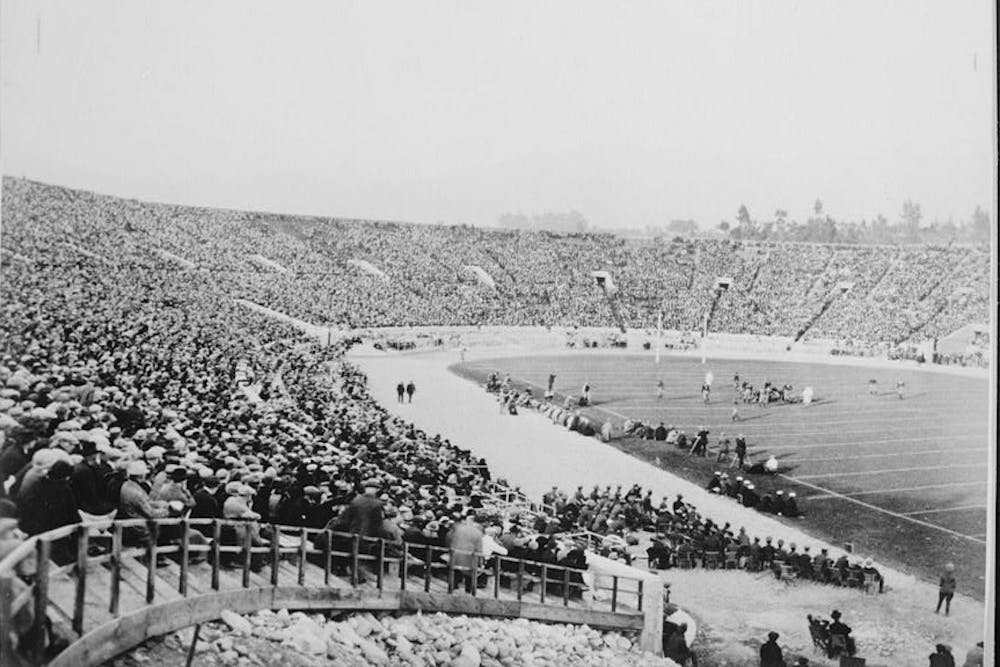On January 1, 1917, 25,000 people packed into the extra grandstand seating at Tournament Park in Pasadena, Calif. to witness a game that would change the landscape of College Football forever.
The Penn Quakers were taking on the Oregon Webfoots in the third-ever Tournament East-West Football Game, a game known today as the Rose Bowl. This marked the first and only appearance in a bowl game by the Quakers, while being the first of eight Rose Bowl appearances for Oregon.
The Webfoots, who were not known as the Ducks for another decade, did not lose a game in the 1916 season, going 6-0-1 with their lone tie coming against rival Washington. The Huskies were declared conference champion in the inaugural season of the Pacific Coast Conference, the precursor to the modern Pac-12 Conference, by virtue of the fact that they played and won one more game than the Webfoots, finishing 7-0-1. The Webfoots only allowed 17 points all season, but did so against fairly weak competition; they beat Willamette 97-0 in their opening game and faced the Multnomah Athletic Club twice during the season.
Similarly, Penn’s 1916 campaign was a very successful one. The Quakers went 7-3-1 and outscored opponents 120-57. The Red and Blue started slow, going 3-2 over the team’s initial five games, but finished strong, going 4-0-1 over their final five games. Penn finished the season with a decisive 23-3 home win against rival Cornell.
The Quakers were led by four All-Americans and flashy quarterback Bert Bell. Bell, who would later go on to be commissioner of the NFL and co-founder of the Philadelphia Eagles, was the son of Pennsylvania’s attorney general and drove around in a Cadillac. This was in stark contrast to Oregon, whose players mainly came from more rural areas and who were led by their only All-American selection, John Beckett, a future member of the College Football Hall of Fame.
“I’ve got only overgrown high school boys, while Penn can field a varsity of big university strength," Oregon coach Hugo Bezdek lamented before the game. "We haven’t a chance.”
At the time, east coast football teams were generally thought of as much stronger than their western counterparts. This had been the consensus dating back to 1902, where, in the first Tournament East-West Football Game, also the first bowl game ever played, the Michigan Wolverines beat Stanford so badly that the Western representative switched from football to rugby following the defeat and it was decided that the game could not be played anymore.
After a 14-year hiatus, the Tournament East-West Football Game returned at the conclusion of the 1915 season, and the Brown Bears traveled to California to take on Washington State. Despite the eventual win by the western team, the feeling of eastern dominance persisted. Brown had only played the game because Syracuse, a much stronger team, was unable to make the trip to California.
RELATED:
In Photos: In a pandemic-altered America, Super Bowl traditions persist in Philadelphia
Former Penn coach Bob Seddon didn't just find success in one sport, but two
Although Oregon finished the 1916 season behind Washington, they were selected to make the trip to Pasadena in January because of the simple fact that train fare was much cheaper to go from Oregon to California than it was to make the trip from Washington.
Almost all contemporary coaches and pundits thought a Penn win was a foregone conclusion. Penn coach Bob Folwell was so confident that he was going to win that he invited Bezdek to come to one of the team’s practices, where he showed the Oregon coach the Quaker’s famed reverse pass play.
“We are going to put a team on the field that won’t be licked and consequently can’t be licked,” Folwell confidently stated prior to the game.
This confidence proved to be the Quaker’s downfall, as the Webfoots broke a 0-0 tie in the third quarter by scoring a touchdown on the exact same reverse pass play from Oregon quarterback Shy Huntington to take a 7-0 lead, which they never relinquished.
“Imagine what we thought and said when Oregon scored its first touchdown of the game on our own play,” Bell said after the game.
Despite a very sloppy first half, the Quakers had a chance to take the lead when they drove all the way down to the Webfoot’s three-yard line, but after a loss of ten yards on the third down, they missed a 29-yard field goal.
The Quakers couldn’t get the ball moving all afternoon. They punted 16 times and Bell threw five interceptions, including three to Huntington.
After Huntington scored on a one-yard scramble in the fourth quarter, he sealed the game with an interception to end Penn’s 79-yard last-minute drive inside the red zone.
This game was a hugely significant one, as the Webfoots' victory signaled a monumental shift in college football experts' attitudes towards eastern and western teams. Following this game, the west coast schools were no longer seen as inferior to those on the east coast.
This was also the final Rose Bowl played between two college teams for two years, as the entry of the United States into World War I led to the game being played between two military teams in 1918 and 1919.
In 1918, the Mare Island Marines, led by former Oregon captain John Beckett, defeated the army’s team from Camp Lewis by a score of 19-7. Beckett ended up serving 50 years in the Marines, eventually achieving the rank of brigadier general and coaching Marine teams all over the country. He was retroactively named the 1917 contest’s MVP in 1953.
The 1917 game would also be Oregon’s last Rose Bowl victory for nearly 100 years, as they lost their next four appearances in the famed game. However, their decisive 1917 victory continues to live on as an important turning point in the history of college football.









